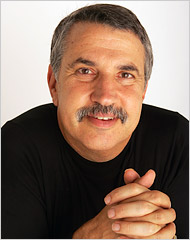
Off to the Races
Dec 19, 2009 - Thomas L. Friedman- The New York Times
 |
| Fred R. Conrad/The New York Times |
| Thomas L. Friedman |
I’ve long believed there are two basic strategies for dealing with climate change — the “Earth Day” strategy and the “Earth Race” strategy. This Copenhagen climate summit was based on the Earth Day strategy. It was not very impressive. This conference produced a series of limited, conditional, messy compromises, which it is not at all clear will get us any closer to mitigating climate change at the speed and scale we need.
Indeed, anyone who watched the chaotic way this conference was “organized,” and the bickering by delegates with which it finished, has to ask whether this 17-year U.N. process to build a global framework to roll back global warming is broken: too many countries — 193 — and too many moving parts. I leave here feeling more strongly than ever that America needs to focus on its own Earth Race strategy instead. Let me explain.
The Earth Day strategy said that the biggest threat to mankind is climate change, and we as a global community have to hold hands and attack this problem with a collective global mechanism for codifying and verifying everyone’s carbon-dioxide emissions and reductions and to transfer billions of dollars in clean technologies to developing countries to help them take part.
But as President Luiz Inácio Lula da Silva of Brazil told this conference, this Earth Day framework only works “if countries take responsibility to meet their targets” and if the rich nations really help the poor ones buy clean power sources.
That was never going to happen at scale in the present global economic climate. The only way it might happen is if we had “a perfect storm” — a storm big enough to finally end the global warming debate but not so big that it ended the world.
Absent such a storm that literally parts the Red Sea again and drives home to all the doubters that catastrophic climate change is a clear and present danger, the domestic pressures in every country to avoid legally binding and verifiable carbon reductions will remain very powerful.
Does that mean this whole Earth Day strategy is a waste? No. The scientific understanding about the climate that this U.N. process has generated and the general spur to action it provides is valuable. And the mechanism this conference put in place to enable developed countries and companies to offset their emissions by funding protection of tropical rain forests, if it works, would be hugely valuable.
Still, I am an Earth Race guy. I believe that averting catastrophic climate change is a huge scale issue. The only engine big enough to impact Mother Nature is Father Greed: the Market. Only a market, shaped by regulations and incentives to stimulate massive innovation in clean, emission-free power sources can make a dent in global warming. And no market can do that better than America’s.
Therefore, the goal of Earth Racers is to focus on getting the U.S. Senate to pass an energy bill, with a long-term price on carbon that will really stimulate America to become the world leader in clean-tech. If we lead by example, more people will follow us by emulation than by compulsion of some U.N. treaty.
In the cold war, we had the space race: who could be the first to put a man on the moon. Only two countries competed, and there could be only one winner. Today, we need the Earth Race: who can be the first to invent the most clean technologies so men and women can live safely here on Earth.
Maybe the best thing President Obama could have done here in Copenhagen was to make clear that America intends to win that race. All he needed to do in his speech was to look China’s prime minister in the eye and say: “I am going to get our Senate to pass an energy bill with a price on carbon so we can clean your clock in clean-tech. This is my moon shot. Game on.”
Because once we get America racing China, China racing Europe, Europe racing Japan, Japan racing Brazil, we can quickly move down the innovation-manufacturing curve and shrink the cost of electric cars, batteries, solar and wind so these are no longer luxury products for the wealthy nations but commodity items the third world can use and even produce.
If you start the conversation with “climate” you might get half of America to sign up for action. If you start the conversation with giving birth to a “whole new industry” — one that will make us more energy independent, prosperous, secure, innovative, respected and able to out-green China in the next great global industry — you get the country.
For good reason: Even if the world never warms another degree, population is projected to rise from 6.7 billion to 9 billion between now and 2050, and more and more of those people will want to live like Americans. In this world, demand for clean power and energy efficient cars and buildings will go through the roof.
An Earth Race led by America — built on markets, economic competition, national self-interest and strategic advantage — is a much more self-sustaining way to reduce carbon emissions than a festival of voluntary, nonbinding commitments at a U.N. conference. Let the Earth Race begin.

|